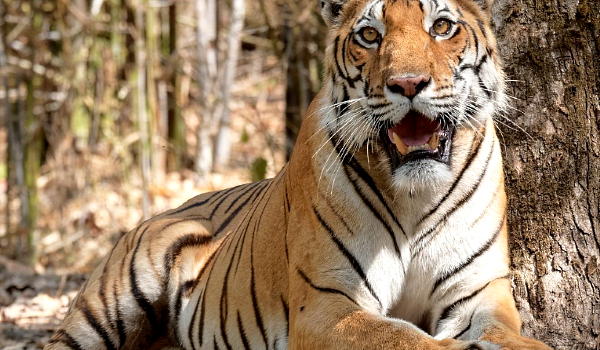
With only a few weeks before we celebrate the Chinese Year of the Tiger, an Orang Asli (OA) villager was fatally mauled by a tiger which was then hunted down and killed.
The survival of the tiger is under serious threat and the main danger it faces is man.
Man is responsible for removing the natural habitat of the tiger. Tigers need space to roam and hunt. Trees in the jungle are felled. The area is converted into oil palm plantations.
Agriculture expansion and development projects like dams, highways, villages and townships add to the loss of tiger habitat.
It is inevitable that the tiger will come into conflict with man.
The national animal of Malaysia is Panthera tigris jacksoni, the Malayan tiger, and it has been adopted by companies like MayBank and Proton.
The tiger is also incorporated in the coats of arms of some royal households.
As a result of man’s activities, tigers may soon become extinct.
Tiger numbers have dwindled significantly from 3,000 in the 1950s to somewhere between 250 and 340 in 2015.
On the morning of January 7, 59-year-old Anek Along from Kampung Sau in Gua Musang went to the back of his house to wash.
His daughter could not find him, noticed blood on the ground, and alerted other villagers to help locate him.
They found a tiger lurking nearby which they claimed had tried to attack them, so they threw spears at it.
They found Anek’s body with head and body wounds. A few hours later, a team of rangers tracked the tiger which they claimed had also tried to attack them, so they killed it.
On January 11, worried by the increased sightings of tigers near their settlements, the OA group representing the Temiar tribe submitted a memorandum to the Prime Minister’s office demanding urgent action to halt deforestation activities.
Their spokesman, Nasir Dollah, blamed mining, logging and large scale plantation projects.
Logging had drastically reduced the wildlife population such as deer, wild boars and monkeys, and had forced tigers to come into conflict with humans by encroaching into villages in search of food.
The following day, January 12, Kelantan Deputy Menteri Besar Mohd Amar Nik Abdullah dismissed the Temiars’ remarks and urged them to stop making baseless claims that illegal logging had displaced the tigers from their habitat.
It was typical for Mohd Amar to say that.
Logging, both legal and illegal, has destroyed many areas in the interior of Kelantan.
Apart from the loss of diversity, heavy rains cause mudslides and intense flooding.
There are allegations that unscrupulous timber barons work hand-in-glove with corrupt government employees in illegal timber activities.
Two and a half weeks later, Kelantan Forestry Director Abdul Khalim Abu Samah also dismissed the OA claims that logging had contributed to the increase in tiger attacks.

In a statement which only served to expose Khalim’s ignorance and scant understanding of conservation and wildlife, he said, “Based on expert research, areas that have been deforested are actually good for the tiger population.
“The tiger population will become larger when small trees grow in the deforested area. The area will see the presence of animals such as mousedeers (sic) which is food for tigers.
“It will be easier for tigers to hunt their preys.”
Khalim showed a simplistic, kindergarten-like knowledge about deforestation. As the director of Kelantan’s Forestry Department, he is the man responsible for the upkeep and management of our forests, but his ignorance about the jungle is alarming.
He appears to be confused about the flora and fauna of a jungle, shows limited knowledge about the threat to various wildlife and sees nothing wrong in logging for the sake of development.
He is undoubtedly the wrong man for the job of Forestry Director.
Has Khalim heard of primary and secondary jungle? Does he know the meaning of diversity and the advantages it brings? Is he aware that poaching decimates tiger populations? Or that the Chinese medicine trade is also a threat to wildlife? Does he realize the importance of the food chain?
Does Khalim know that new species of animals, plants and trees do not suddenly sprout overnight when the jungle is cleared? On the other hand, belukar or impenetrable secondary growth will emerge when the jungle canopy is removed.
The other question that puzzles many Malaysians is why the tiger which attacked Anek had to be killed.
Whilst Anek’s death is tragic and sad, the fact is that man had encroached on the tiger’s territory!
When the villagers threw spears at the tiger, naturally the animal charged at them. Wouldn’t you if someone threw things at you?
Later that day, the rangers shot and killed the tiger because they claimed it charged at them.
Of course it did!. It had been wounded and was fighting for survival. So, why were tranquilizer darts not used so that the tiger could be later released in a forest sanctuary like the Belum-Temongor forest?
Was the tiger’s carcass suitably disposed of or donated to a veterinary research facility, or were the body parts sold for a handsome profit on the black market?
In some countries with a tiger or any other endangered animal conservation program, the animal’s wounds would have been treated, a tracking device attached to it, and data like its weight, length, height, condition of its teeth, scars and the general state of its health would be recorded, before release.
Tigers are solitary creatures and will not normally come near humans.
As the apex predator, tigers ensure that the forest ecosystem is kept in balance.
Roaming over large areas, it is inevitable that the tiger will encroach upon agricultural areas and the fringes of the forest, to make contact with man.
When this happens, the tiger faces the greatest threat, as it is hunted as a perceived threat to human life, or as a trophy.
So, how serious are we about saving the Malayan tiger?
Gong Xi Fa Cai!
Sources:
- Malaysiakini: Deforested area good for tigers, claims K’tan Forestry director
- Mongabay: ‘Huge blow’ for tiger conservation as two of the big cats killed in Thailand
(Mariam Mokhtar is a Freelance Writer.)
ADVERTISEMENT
ADVERTISEMENT






































